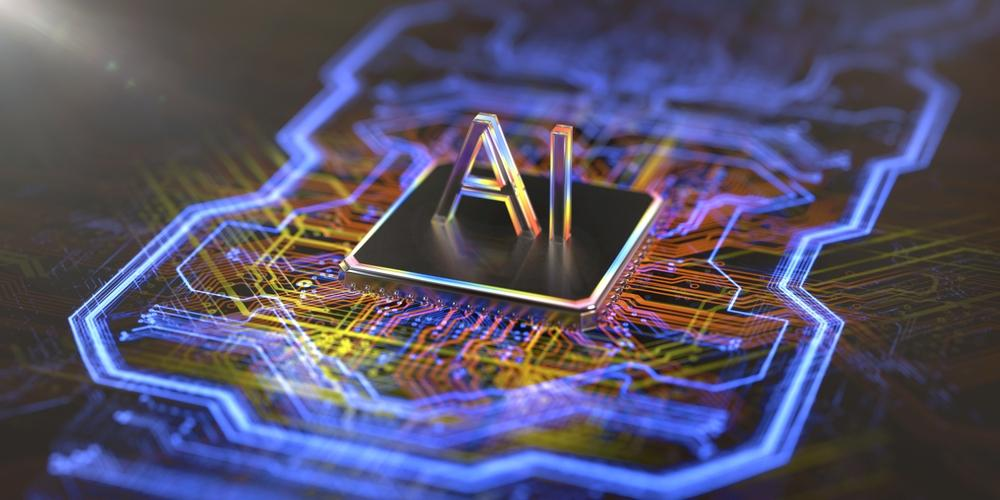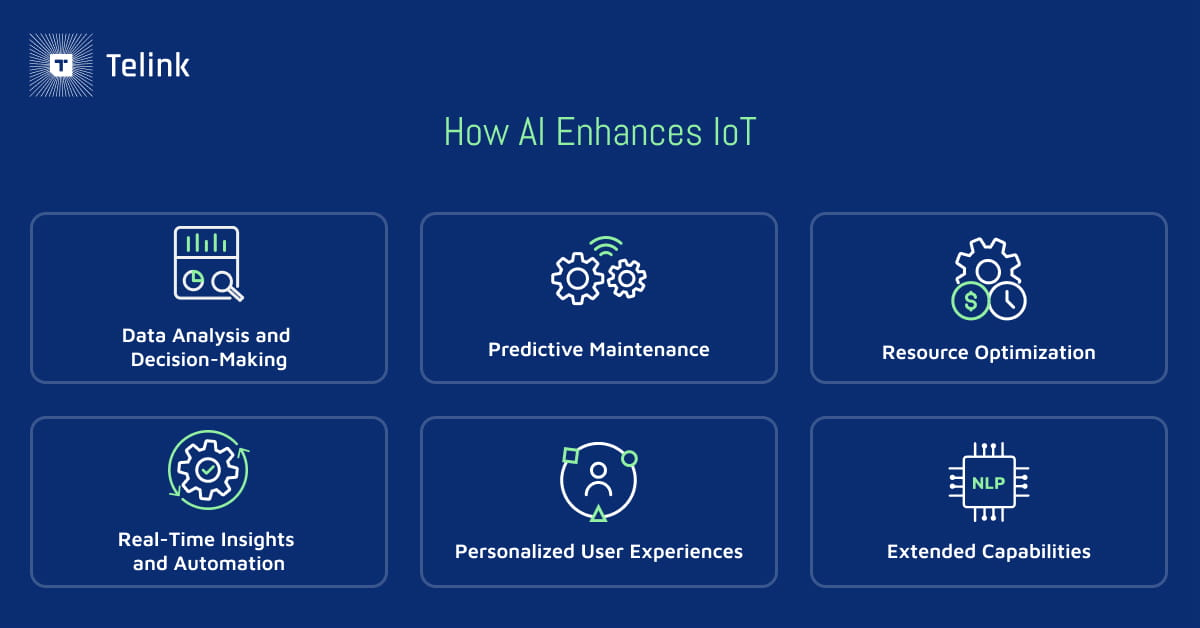



PLEASE ROTATE ME


Telink Staff
July 2, 2024

Uncover how combining AI and IoT can redefine how we interact with technology in everyday life.
Nowadays, it seems like artificial intelligence (AI) has seeped into every facet of our lives. We’re able to play music by speaking to devices; diagnose conditions based on real-time health vitals; automate job tasks to optimize productivity at work; and so much more. In fact, AI is increasingly becoming integrated into IoT systems to make human-device interactions feel more natural and intuitive. With the AI in IoT market growing at a CAGR of nearly 8% from 2024 to 2029, industries are heavily investing in and ideating opportunities where machine learning, generative AI, and natural language processing can enhance vast networks of interconnected devices.
This spells more creative opportunities for users and developers looking to combine AI with IoT to create smarter, more efficient technological environments. Let’s take a closer look.
The line between AI and IoT can often be blurred, especially since both technologies involve intelligence software that imbue proactive qualities in devices. However, understanding AI’s and IoT’s distinct roles can help users and developers best leverage each tool to their fullest potential.
AI represents a leap forward in computing capabilities, designed to simulate human intelligence in the way machines think, learn, and solve problems. It allows devices and platforms to analyze complex datasets, recognize patterns, and make decisions with increasing accuracy and efficiency. For example, machine learning algorithms, enable devices to learn from data and adapt their behavior without human intervention. Neural networks, inspired by the human brain's structure, excel at tasks like image and speech recognition, enhancing the capabilities of AI-powered applications. And natural language processing (NLP) allows machines to understand and generate human language to better support interactions between users and AI systems.
IoT, on the other hand, encompasses a network of interconnected devices equipped with sensors and software that enable them to collect, exchange, and act upon data. These devices span various domains, from smart home appliances to industrial sensors to wearable health monitors. Essentially, AI is the brains behind high-level operations, while IoT offers the hardware infrastructure to make it physically happen.

IoT provides the hardware infrastructure necessary to capture data from the physical world and perform actions decided on by AI systems, such as:
AI processes vast amounts of data from IoT devices to extract meaningful insights and patterns. For instance, in agriculture, AI algorithms may analyze environmental data collected by sensors to optimize irrigation schedules based on soil moisture levels and weather forecasts, maximizing crop yields while conserving water resources.
AI-driven predictive maintenance can help industries predict equipment failures before they occur. By analyzing performance data from IoT sensors, AI algorithms can detect anomalies and forecast maintenance needs, reducing downtime, minimizing repair costs, and enhancing operational efficiency.
AI can optimize resource usage within IoT systems by adjusting energy consumption in smart grids or inventory management in logistics based on real-time data trends.
AI powers live data analysis, helping IoT systems respond immediately to changing conditions. For instance, healthcare devices equipped with AI can continuously monitor patient health metrics and autonomously alert healthcare providers to critical changes, facilitating timely interventions and personalized patient care.
AI leverages data collected from IoT devices to deliver tailored experiences that align with individual preferences. Smart home assistants, for example, can learn user habits and adjust settings like lighting and temperature automatically, improving user comfort and convenience.
Recent advancements in Generative AI, like ChatGPT, expand the possibilities of IoT applications. For example, ChatGPT’s natural language processing capabilities enable voice-activated devices to interact with users more seamlessly. However, integrating Generative AI tools into IoT systems necessitates thoughtful consideration of factors such as input field character limits, API usage pricing models, data privacy concerns, and the possibility of biases stemming from outdated information.
Nonetheless, with various applications and use cases available, the benefits of marrying AI with IoT open up avenues for ingenuity.
AI and IoT integration has led to transformative applications across various sectors, such as:
As AI and IoT refines how devices operate in sectors like smart homes to healthcare and beyond, this technological duo opens doors for developers to continue to innovate across industries.
Although AI is proving to be an exciting frontier, integrating it into IoT systems presents challenges that must be addressed to ensure successful deployment and operation.
Not all AI tools and platforms are the same. Be sure to do extensive research to vet your options and decide which solution is the best fit for your existing IoT ecosystem.
There are many new opportunities for users and developers to leverage as AI becomes intertwined with IoT networks. Having grasped the dynamics of these technologies, here’s how users can find the best tool for their IoT framework:
1. Start by identifying the specific needs and goals of your IoT system that AI can address, such as increasing productivity or improving user interactions.
2. Choose the right AI technologies and tools to support your IoT objectives, whether that’s machine learning for forecasting or natural language processing for better human-machine communication.
3. Make sure you have the right setup to handle AI. This could mean setting up cloud services or using edge computing for real-time data processing.
4. Gather and clean data from IoT devices. Cleaning and organizing your data are key steps to making sure AI gets accurate information for making decisions.
5. Create AI models that work well with your IoT setup. Train these models with data that matches your real-world conditions, and keep refining them to make sure they keep working as things change.
6. Once deployed, continuously monitor the AI solution and IoT system to ensure it operates effectively, making adjustments and improvements as needed.
For developers, incorporating AI into IoT devices involves several key steps:
1. Determine where AI can add value to your IoT device.
2. Choose appropriate AI technologies based on your use case (e.g., computer vision for image recognition, machine learning for data analysis, etc.).
3. Embed AI into the device's design, specifying how AI will interact with sensors, actuators, and user interfaces to achieve desired functionalities.
4. Build and train AI models using relevant data collected from IoT sensors. Make sure the data is organized and updated.
5. Implement AI models into the device's firmware or software architecture. Ensure compatibility and efficient data processing between IoT sensors and AI algorithms.
6. Conduct rigorous testing to validate AI functionality within the IoT device. Test under various conditions to ensure reliability, accuracy, and real-time responsiveness.
7. Monitor AI performance post-deployment and update models as needed based on user feedback and evolving data patterns.
In need of hardware and software support to smoothly introduce AI to your IoT devices? Telink can help.
The convergence of AI with IoT marks a monumental shift in technology and is already reshaping a multitude of industries. Evolve alongside these changes with Telink. Our SoCs and development kits can be used in many diverse applications, from smart retail and asset tracking to wireless gaming and home audio connections. Dedicated to designing ICs that simply work, Telink follows a protocol agnostic approach to help your IoT environment thrive even when the market changes.
Visit Telink’s wiki to learn more about our development tools, ask us a question through our Technical Forum, or contact us directly today.